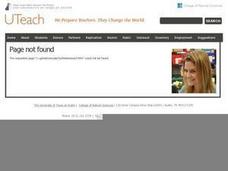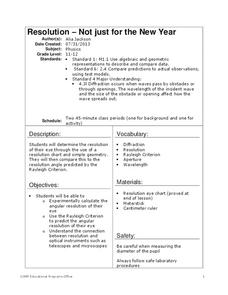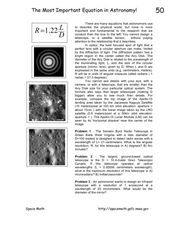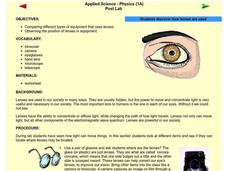Optical Telescope Teacher Resources
Find Optical Telescope lesson plans and worksheets
Showing 84 resources
Lesson Planet Curated
Crash Course: Physics
Dr. Shini Somara narrates a 46-video Crash Course Physics course based on the 2016 AP Physics I and II curriculum. Topics covered include linear, circular, rotational, simple harmonic, 2D motion, derivatives, integrals, vectors, Newton’s...
Curated OER
Optics: Light at Work - Part 1
Any work with light, lenses, lasers, or mirrors is called optical engineering. Optical engineers bend and bounce light to make it useful for humans. Examples are telescopes, invisibility, nanomedicine, and solar energy. This...
Crash Course
Optical Instruments: Crash Course Physics #41
How does a lens work? A thorough video lesson addresses this question by looking at the lenses of human eyes, telescopes, and microscopes. Light waves play an important role function of each of these objects. This is the 41st lesson in...
Institute of Electrical and Electronics Engineers
Telescoping Periscope
Ahoy, matey! Here is an engineering expedition that mini mariners are sure to be swept away by! After reading a brief description and history of periscopes, they work in crews to construct one. Use this activity to enhance a...
Urbana School District
Optics
Don't worry, optics is a light topic! The presentation covers reflection, refraction, fiber optics, mirages, prisms, rainbows, dispersion, mirrors, lenses, telescopes, diffraction, the human eye, and much, much more. Presentation is...
NASA
Taking a Cold, Clear Look at the Universe
Take a look with another perspective. Pupils read to find out what portion of the electromagnetic spectrum a space telescope sees and the difficulties of viewing infrared radiation from other objects in space. Individuals discover how...
Curated OER
Online Exploration: Telescopes From the Ground Up
Students explore a web-based illustrated text and interactive graphics to determine the relationship between the operation of telescopes and light. optics. They work in small groups to become an expert on one of the ten eras of telescope...
Curated OER
Light and Optics
Third graders utilize the scientific method to explain light and optics in this five lessons unit. Through experimentation and discussion, 3rd graders canvass the concepts of light traveling, reflection and refraction.
Science Friday
Pinhole Viewer
Take a peep into optics. Pupils watch a video about a large Polaroid camera before building pinhole viewers. The scholars then create different types of viewers and compare them to determine which provides the best image.
Curated OER
Hubble Space Telescope Webquest
Learners research the Hubble Space Telescope. In this Hubble Space Telescope lesson, students complete a webquest about the Hubble Space Telescope.
Curated OER
Our Solar System
Learners analyze the theories of the formation of the universe and solar system. Students analyze planetary motion and the physical laws that explain that motion: Rotation, Revolution, Apparent diurnal motions of the stars, sun, and...
Curated OER
Building a Telescope
Students construct a simple refracting telescope. They calculate the magnification.
Curated OER
Algebra: Mirror, Mirror on the Universe
Students assess how algebra, telescopes, space exploration and optics are so important in astronomy. They encounter studies on the Hubble Space Telescope, Hubble Deep Field and how algebra helps to determine the effects of contamination...
Curated OER
A Distant View
Students investigate the essential concepts of how lenses work to magnify vision, and then build simple telescopes to demonstrate their understanding. They write a description of how their telescope could be improved and how it works.
Curated OER
A Galaxy Up Close
In this Sombrero Galaxy worksheet, students observe infrared images taken by the Spitzer Infrared Telescope and the Hubble Space Telescope. They answer 9 questions about the details of the images such as the radius of the stellar...
Cornell University
Resolution—Not Just for the New Year
Experiment with optical resolution using an inquiry-based lesson. Young researchers calculate fellow classmates' optical resolutions. They apply the information to understand the inner workings of optical instruments.
NASA
Collecting Electromagnetic Radiation
Astronomy is literally over your head, but this lesson will explain how we study it. Young scientists make telescopes, calculate and compare the light gathering power of lenses, and simulate detection of infared radiation....
Curated OER
Detecting Meteors by Radio in the Classroom
Twelfth graders describe and interpret the science of optical and radio telescopes, space probes and remote sensing technologies (Unit E) They explain the role of radio and optical telescopes in determining characteristics of stars and...
Curated OER
Radiation From Space
For this space worksheet, students will review different aspects of light, sound, and radio waves in space and the use of different types of telescopes. This worksheet has 17 fill in the blank statements.
Curated OER
The Most Important Equation in Astronomy!
In this astronomy optics learning exercise, students calculate the angular resolution and maximum resolution for given telescope specifics. This learning exercise has 3 problems to solve.
Curated OER
Seeing Interference Fringes with a Telescope
Students construct an interferometer using a simple telescope. In this physics instructional activity, students explain how light waves create the fringe patterns. They observe patterns made by different objects in the sky and compare them.
Curated OER
Lenses
Students explore vision by experimenting with lenses in equipment. In this optics lesson plan, students define the different technology that enhances vision such as microscopes, telescopes and cameras. Students experiment with these...
Curated OER
Observing the Outer Planets
Students observe the outer planets. In this science activity, students use a telescope locate the outer planets of the solar system. Students create a video of their observations.
Curated OER
Looking into Space
Learners explore how telescopes work, build a model of their own, and consider how real telescopes can be used to ask-and help answer-questions about the universe.

























